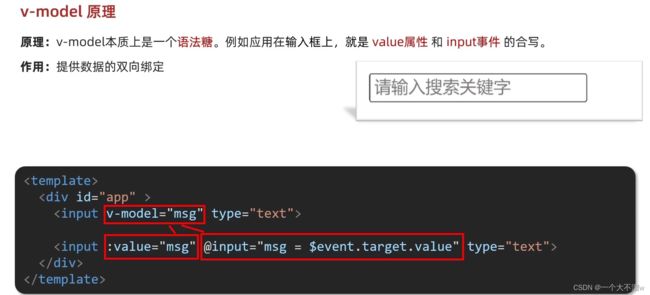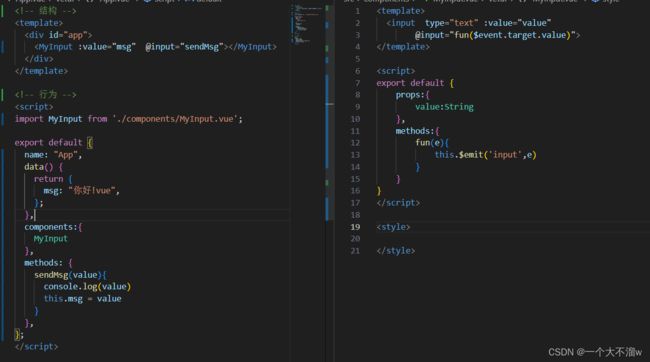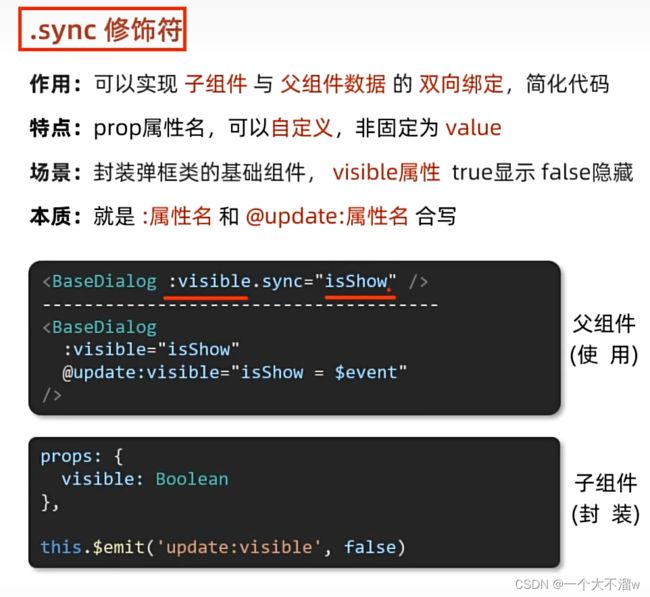- (教程)如何在HTML网页里嵌入PDF文件?
IDRSolutions_CN
pdf图像处理htmlhtml5团队开发
开发者可以使用不同的标签在HTML中嵌入PDF文件,常见的有、和。它们都能在网页应用中显示PDF,但哪种方式更好?有没有比这更好的方式来在浏览器中显示PDF?方法1:使用标签如果不需要回退内容,可以使用标签。缺点:不常用,因为如果浏览器不支持PDF,显示会是一片空白。YourbrowserdoesnotsupportPDFfiles.Downloadthefileinstead方法2:使用标签标签
- PakePlus支持将vue/react等项目打包为跨平台桌面软件了
1024小神
多端开发vue.js前端javascript
PakePLus介绍Turnanywebpage/Vue/ReactandsoonintoadesktopappandmobileappwithRust.轻松将任意网站/Vue/React等项目构建为轻量级(仅5M)多端桌面应用和多端手机应用。pakeplus开源地址:GitHub-Sjj1024/PakePlus:Turnanywebpage/Vue/Reactandsoonintoadeskt
- Vue.js 中的 Memoization:提升性能的缓存技术
vvilkim
vuevue.js前端javascript
在现代前端开发中,性能优化是一个永恒的话题。随着应用规模的增大,复杂的计算和频繁的函数调用可能会导致性能瓶颈。Vue.js作为一个流行的前端框架,提供了多种优化手段,其中memoization(记忆化)就是一种非常有效的技术。本文将详细介绍Vue.js中的memoization,以及如何利用它来提升应用性能。什么是Memoization?Memoization是一种优化技术,通过缓存函数的结果来避
- Vue.js 性能优化:虚拟 DOM 与虚拟滚动
vvilkim
vuevue.js前端javascript
在现代前端开发中,性能优化是一个永恒的话题。Vue.js作为一款流行的前端框架,提供了许多强大的工具和技术来提升应用的性能。其中,虚拟DOM和虚拟滚动是两个非常重要的概念。本文将深入探讨它们的原理、优势以及如何在Vue.js中使用它们来优化性能。什么是虚拟DOM?虚拟DOM(VirtualDOM)是Vue.js用于提升性能的核心技术之一。它是一个轻量级的JavaScript对象树,用于表示真实DO
- Vscode niuhe 插件使用教程 - xorm 代码生成
诗意地回家
niuhe插件vscodeide编辑器
官方教程已经上线,请访问:http://niuhe.zuxing.net本文相关项目:vue3-element-admin基于niuhe插件的管理后台模板niuhe-mdbookniuhe插件示例项目在日常开发中,新增数据库表时通常需要编写大量重复的增删改查代码。为提高开发效率,niuhe插件0.3.4版本新增Xorm基础代码生成功能,可自动生成:数据库表对应的Golang模型结构体基础CURD操
- 用python执行js代码:PyExecJS库详解
数据知道
2025年爬虫和逆向教程pythonjavascript爬虫数据采集nodejs
更多内容请见:爬虫和逆向教程-专栏介绍和目录文章目录1.介绍和安装1.1PyExecJS介绍1.2安装JavaScript运行时1.3安装PyExecJS2.PyExecJS的基本使用2.1执行简单的JavaScript代码2.2使用外部JavaScript文件2.3先编译、后调用2.4传递参数和获取返回值3.PyExecJS的高级功能3.1指定JavaScript运行时3.2处理异步JavaSc
- 响应式数据 和 Pinia 状态
肉肉不吃 肉
前端vue.jspinia
响应式数据和Pinia状态是Vue.js应用中用于管理数据的两种重要机制,它们之间有密切的关系。以下是它们的定义、特点以及关系:1.响应式数据定义响应式数据是Vue.js的核心特性之一,指的是当数据发生变化时,视图会自动更新。Vue.js通过Proxy或Object.defineProperty实现数据的响应式。特点自动更新:当数据变化时,依赖该数据的视图会自动更新。声明式:开发者只需关注数据本身
- 【 <二> 丹方改良:Spring 时代的 JavaWeb】之 Spring Boot 中的 RESTful API 设计:从上手到骨折
Foyo Designer
springspringbootrestfulSpringMVCAsyncCrossOrigin
点击此处查看合集https://blog.csdn.net/foyodesigner/category_12907601.html?fromshare=blogcolumn&sharetype=blogcolumn&sharerId=12907601&sharerefer=PC&sharesource=FoyoDesigner&sharefrom=from_link一、开篇整活儿咱今儿个唠唠Spr
- 全网最详细!vue中使用flv.js 播放直播监控视频流
抄一下你代码
在vue中使用flv.js播放监控摄像头/直播vue.js
老规矩,先安装flv.js插件npminstallflv.js在组件中的使用**注意事项放后面我怕你们不看呐!!!!1.必须在dom加载完成后再执行直播视频流的填充方法!2.在一个网页中最多同时容纳6个监控视频播放!第七个绝对加载不出来!3.在离开这个页面的时候必须销毁播放容器,不然会占用TCP个数,导致其他页面的监控也播放不了**importflvjsfrom"flv.js";//页面代码//1
- JAVA毕业设计BS架构考研交流学习平台设计与实现计算机源码+lw文档+系统+调试部署+数据库
瑞致网络
java开发语言jvm
JAVA毕业设计BS架构考研交流学习平台设计与实现计算机源码+lw文档+系统+调试部署+数据库JAVA毕业设计BS架构考研交流学习平台设计与实现计算机源码+lw文档+系统+调试部署+数据库本源码技术栈:项目架构:B/S架构开发语言:Java语言开发软件:ideaeclipse前端技术:Layui、HTML、CSS、JS、JQuery等技术后端技术:JAVA运行环境:Win10、JDK1.8数据库:
- [附源码]Python计算机毕业设计SSM基于B-S的心理健康管理系统(程序+LW)
Python、JAVA毕设程序源码
java开发语言
环境配置:Jdk1.8+Tomcat7.0+Mysql+HBuilderX(Webstorm也行)+Eclispe(IntelliJIDEA,Eclispe,MyEclispe,Sts都支持)。项目技术:SSM+mybatis+Maven+Vue等等组成,B/S模式+Maven管理等等。环境需要1.运行环境:最好是javajdk1.8,我们在这个平台上运行的。其他版本理论上也可以。2.IDE环境:
- 5-1 使用ECharts将MySQL数据库中的数据可视化
上课的牛马
实训大数据
方法一:使用PythonFlask框架搭建API对于技术小白来说,使用ECharts将MySQL数据库中的数据可视化需要分步骤完成。以下是详细的实现流程:一、技术架构后端服务:使用PythonFlask框架搭建API(简单易学,适合新手)数据库连接:通过Python的pymysql库连接MySQL前端可视化:HTML+JavaScript+ECharts数据流向:MySQL数据库→Pyt
- 计算机毕业设计JavaBS景区票务管理系统设计与实现(源码+系统+mysql数据库+lw文档)
毅铭科技
数据库
计算机毕业设计JavaBS景区票务管理系统设计与实现(源码+系统+mysql数据库+lw文档)计算机毕业设计JavaBS景区票务管理系统设计与实现(源码+系统+mysql数据库+lw文档)本源码技术栈:项目架构:B/S架构开发语言:Java语言开发软件:ideaeclipse前端技术:Layui、HTML、CSS、JS、JQuery等技术后端技术:JAVA运行环境:Win10、JDK1.8数据库:
- 3分钟带你了解Vue3的nextTick()
嫣嫣细语
vue.js前端javascriptvue.jsjavascript前端
前言Vue实现响应式并不是数据发生变化之后DOM立即变化,而是按一定的策略进行DOM的更新。简单来说,Vue在修改数据后,视图不会立刻更新,而是等同一事件循环中的所有数据变化完成之后,再统一进行视图更新,nextTick()方法就会在这样的DOM更新循环结束后调用指定的函数。概念在Vue3中nextTick()方法的行为和Vue2中基本相似,但它进行了一些优化,以提高性能和稳定性。nextTick
- 金融、教育等行业如何高效利用wangEditor实现word文档网页化编辑?
2501_90699850
金融wordumeditor粘贴wordueditor粘贴wordueditor复制wordueditor上传word图片ueditor导入word
要求:开源,免费,技术支持编辑器:wangEditor前端:vue2,vue3,vue-cli,html5后端:java,jsp,springboot,asp.net,php,asp,.netcore,.netmvc,.netform群体:学生,个人用户,外包,自由职业者,中小型网站,博客,场景:数字门户,数字中台,站群,内网,外网,信创国产化环境,web截屏行业:医疗,教育,建筑,政府,党政,国
- 网页编辑器能否满足Word公式与图片的直接复制粘贴?
2501_90699800
编辑器wordumeditor粘贴wordueditor粘贴wordueditor复制wordueditor上传word图片ueditor导入word
要求:开源,免费,技术支持编辑器:百度ueditor前端:vue2,vue3,vue-cli,react,html5用户体验:Ctrl+V快捷键操作功能:导入Word,导入Excel,导入PPT(PowerPoint),导入PDF,复制粘贴word,导入微信公众号内容,web截屏平台:Windows,macOS,Linux,RedHat,CentOS,Ubuntu,中标麒麟,银河麒麟,统信UOS,
- 数据分析面临的三大挑战该如何解决
銨靜菂等芐紶
数据挖掘大数据数据分析
转载自品略图书馆http://www.pinlue.com/article/2020/09/0712/2611202048648.html有效的分析已成为决定性因素,很明显,掌握它的人会蓬勃发展。但是,实现这一目标的过程并非没有障碍。最常见的数据分析挑战是什么?公司如何自信地应对它们?下面就来介绍一下。1、浏览预算限制数据分析领导者需要在当下采取行动,但同时也需要考虑未来。平衡这些需求要求他们在制
- 高级前端面试题-React
圣诞小子
javascript面试
react概念类组件和函数组件,什么时候用类组件获取组件实例类组件如何实现逻辑复用?高阶组件、renderprops选择hooks的优点状态逻辑复用;状态逻辑集中,易于理解;类组件不利于优化,比如不能很好的压缩为什么要用hooks,解决了什么问题同上react的context的使用场景共享对一个组件树全局的信息,不需要一层层传参受控组件和非受控组件非受控组件:数据只保存在内部state中;受控组件
- GS-SLAM论文阅读笔记-MGSO
zenpluck
GS论文阅读论文阅读笔记
前言MGSO首字母缩略词是直接稀疏里程计(DSO),我们建立的光度SLAM系统和高斯飞溅(GS)的混合。这应该是第一个前端用DSO的高斯SLAM,不知道这个系统的组合能不能打得过ORB-SLAM3,以及对DSO会做出怎么样的改进以适应高斯地图,接下来就看一下吧!GishelloG^s_ihelloGishello我是红色文章目录前言1.背景介绍2.关键内容2.1SLAMmodule2.2Dense
- HTML5响应式使用css媒体查询
前段技术人
html5css媒体
HTML负责搭建页面结构,CSS负责样式设计,并且通过媒体查询实现了较好的响应式效果,能够适应不同屏幕尺寸下面就是写了一个详细的实例。CSS部分*{margin:0;padding:0;box-sizing:border-box;}*是通配选择器,会选中页面上的所有元素。margin:0;将所有元素的外边距设置为0。padding:0;将所有元素的内边距设置为0。box-sizing:border
- 前端面试:[React] Recoil 里面 selector 支持哪些参数?
returnShitBoy
前端面试react.js
在Recoil中,selector用于派生状态并可以通过传递不同的参数来实现更强大的功能。创建selector时,可以传入以下参数:1.key类型:string描述:是selector的唯一标识符。每个selector和atom都必须有一个唯一的key,否则会抛出错误。这个key用于在Recoil状态树中进行识别。示例:javascriptconstmySelector=selector({key
- Python Textract库:文本提取
程序员喵哥
python开发语言
更多Python学习内容:ipengtao.comTextract是一个强大的Python库,用于从各种文件格式中提取文本。无论是PDF、Word文档、Excel电子表格、HTML页面还是图像,Textract都能有效地提取其中的文本内容。Textract通过集成多种开源工具和库,实现了对多种文件格式的支持,使得文本提取变得简单而高效。本文将详细介绍Textract库的安装、主要功能、基本操作、高
- 一个比Fiddler/Charles更好用的免费抓包神器
金丝猴也是猿
httpudphttpswebsocket网络安全网络协议tcp/ip
Proxyman与Sniffmaster:抓包工具的双剑合璧在当今的网络开发与调试中,抓包工具是不可或缺的利器。无论是前端开发者、后端工程师,还是安全研究人员,都需要通过抓包工具来分析网络请求、调试接口、排查问题。今天,我们将介绍两款强大的抓包工具:Proxyman和Sniffmaster,它们各自拥有独特的功能,能够帮助你在不同的场景下高效完成工作。Proxyman简介Slogan:只是简单地点
- 在网页跑3D多人互动之渲染效能瓶颈
微网兔子
後端技術前端网络服务器c++unity架构3d
累积到目前测试回馈给我们的心得,主要问题还是在前端显示的部分。所以就来聊聊在网页跑3D多人互动之渲染效能瓶颈!!!数万个3D角色与场景物件需即时渲染,导致GPU/CPU过载,低端设备卡顿。已经使用的解决方案:LOD(LevelofDetail)技术:根据距离动态调整模型细节,远距离使用低多边形模型。InstancedRendering:批次渲染相同模型(如重复的树木、建筑物)。Culling(剔除
- 使用Three.js渲染器创建炫酷3D场景
引言在当今数字化的时代,3D图形技术正以其独特的魅力在各个领域掀起波澜。从影视制作到游戏开发,从虚拟现实到网页交互,3D场景以其强烈的视觉冲击力和沉浸式的体验,成为了吸引用户、传达信息的重要手段。而Three.js,作为一款功能强大且广受欢迎的JavaScript3D库,为我们提供了便捷、高效的途径来创建令人炫目的3D场景。本文将深入探讨使用Three.js渲染器创建炫酷3D场景的方方面面,带领读
- html 5中哪个标签用于定义标题列表项,No.5 HTML常用标签
李诗旸
html5中哪个标签用于定义标题列表项
一、标题标签为了使网页更具有语义化,我们经常会在页面中用到标题标签。HTML提供了6个等级的网页标题,即至。我是一级标题我是二级标题我是三级标题我是四级标题我是五级标题我是六级标题单词head的缩写,意为头部、标题。标签语义:作为标题使用,并且依据重要性递减。特点:加了标题的文字会变的加粗,字号也会依次变大。一个标题独占一行。二、段落标签在网页中,要把文字有条理地显示出来,就需要将这些文字分段显示
- 什么是 HTML 实体和转义
西门吹雪在编程
前端开发html前端
在网页前端的源代码中,你可能会看到"这种字符串。这种字符串实际上是HTML实体之一,用于表示双引号字符(")。HTML实体是一种用于在HTML文档中表示某些特殊字符的方法,因为这些字符在HTML中有特定的用途或可能会与HTML标签语法冲突。HTML实体的背景和用途在HTML中,一些字符有特定的意义。例如,用于标记HTML标签的开始和结束。如果你想在网页中显示这些字符而不是把它们解释为HT
- Vue3连接SSE,并且返回结果用打字机效果呈现
陈琦鹏
前端javascript前端vue.js
话不多说直接上代码连接SSEimport{ref,onMounted,onUnmounted}from'vue';constsse=ref()constreconnectAttempts=ref(0)consttimer=ref()onMounted(()=>{initSSE();})onUnmounted(()=>{if(sse.value){sse.value.close();}//清除定时器
- HTML中的零宽字符
Jinuss
前端html前端
概述零宽字符是一组在文本中没有可见宽度的字符,它们通常用于处理文本的布局、分隔和合成。下面是一些常见的零宽字符及其详细介绍:详细介绍零宽空格(ZeroWidthSpace,ZWSP)Unicode码位:U+200BHTML实体:或用途:用于防止文字自动换行。用于在文本中插入不可见的间隔,以控制排版或进行文本分析。零宽非连字符(ZeroWidthNon-Joiner,ZWNJ)Unicode码位:U
- 用Babel操作AST实现JavaScript代码的自动化生成与转换
目录目录环境搭建代码:修改AST的逻辑重命名函数名重命名变量并修改变量值函数调用替换控制流扁平化还原删除未使用的变量对象属性简化条件表达式优化表达式还原环境搭建安装环境npminstall@babel/parser@babel/traverse@babel/generator@babel/typesast转换的代码框架constfs=require('fs');constvm=require('n
- tomcat基础与部署发布
暗黑小菠萝
Tomcat java web
从51cto搬家了,以后会更新在这里方便自己查看。
做项目一直用tomcat,都是配置到eclipse中使用,这几天有时间整理一下使用心得,有一些自己配置遇到的细节问题。
Tomcat:一个Servlets和JSP页面的容器,以提供网站服务。
一、Tomcat安装
安装方式:①运行.exe安装包
&n
- 网站架构发展的过程
ayaoxinchao
数据库应用服务器网站架构
1.初始阶段网站架构:应用程序、数据库、文件等资源在同一个服务器上
2.应用服务和数据服务分离:应用服务器、数据库服务器、文件服务器
3.使用缓存改善网站性能:为应用服务器提供本地缓存,但受限于应用服务器的内存容量,可以使用专门的缓存服务器,提供分布式缓存服务器架构
4.使用应用服务器集群改善网站的并发处理能力:使用负载均衡调度服务器,将来自客户端浏览器的访问请求分发到应用服务器集群中的任何
- [信息与安全]数据库的备份问题
comsci
数据库
如果你们建设的信息系统是采用中心-分支的模式,那么这里有一个问题
如果你的数据来自中心数据库,那么中心数据库如果出现故障,你的分支机构的数据如何保证安全呢?
是否应该在这种信息系统结构的基础上进行改造,容许分支机构的信息系统也备份一个中心数据库的文件呢?
&n
- 使用maven tomcat plugin插件debug关联源代码
商人shang
mavendebug查看源码tomcat-plugin
*首先需要配置好'''maven-tomcat7-plugin''',参见[[Maven开发Web项目]]的'''Tomcat'''部分。
*配置好后,在[[Eclipse]]中打开'''Debug Configurations'''界面,在'''Maven Build'''项下新建当前工程的调试。在'''Main'''选项卡中点击'''Browse Workspace...'''选择需要开发的
- 大访问量高并发
oloz
大访问量高并发
大访问量高并发的网站主要压力还是在于数据库的操作上,尽量避免频繁的请求数据库。下面简
要列出几点解决方案:
01、优化你的代码和查询语句,合理使用索引
02、使用缓存技术例如memcache、ecache将不经常变化的数据放入缓存之中
03、采用服务器集群、负载均衡分担大访问量高并发压力
04、数据读写分离
05、合理选用框架,合理架构(推荐分布式架构)。
- cache 服务器
小猪猪08
cache
Cache 即高速缓存.那么cache是怎么样提高系统性能与运行速度呢?是不是在任何情况下用cache都能提高性能?是不是cache用的越多就越好呢?我在近期开发的项目中有所体会,写下来当作总结也希望能跟大家一起探讨探讨,有错误的地方希望大家批评指正。
1.Cache 是怎么样工作的?
Cache 是分配在服务器上
- mysql存储过程
香水浓
mysql
Description:插入大量测试数据
use xmpl;
drop procedure if exists mockup_test_data_sp;
create procedure mockup_test_data_sp(
in number_of_records int
)
begin
declare cnt int;
declare name varch
- CSS的class、id、css文件名的常用命名规则
agevs
JavaScriptUI框架Ajaxcss
CSS的class、id、css文件名的常用命名规则
(一)常用的CSS命名规则
头:header
内容:content/container
尾:footer
导航:nav
侧栏:sidebar
栏目:column
页面外围控制整体布局宽度:wrapper
左右中:left right
- 全局数据源
AILIKES
javatomcatmysqljdbcJNDI
实验目的:为了研究两个项目同时访问一个全局数据源的时候是创建了一个数据源对象,还是创建了两个数据源对象。
1:将diuid和mysql驱动包(druid-1.0.2.jar和mysql-connector-java-5.1.15.jar)copy至%TOMCAT_HOME%/lib下;2:配置数据源,将JNDI在%TOMCAT_HOME%/conf/context.xml中配置好,格式如下:&l
- MYSQL的随机查询的实现方法
baalwolf
mysql
MYSQL的随机抽取实现方法。举个例子,要从tablename表中随机提取一条记录,大家一般的写法就是:SELECT * FROM tablename ORDER BY RAND() LIMIT 1。但是,后来我查了一下MYSQL的官方手册,里面针对RAND()的提示大概意思就是,在ORDER BY从句里面不能使用RAND()函数,因为这样会导致数据列被多次扫描。但是在MYSQL 3.23版本中,
- JAVA的getBytes()方法
bijian1013
javaeclipseunixOS
在Java中,String的getBytes()方法是得到一个操作系统默认的编码格式的字节数组。这个表示在不同OS下,返回的东西不一样!
String.getBytes(String decode)方法会根据指定的decode编码返回某字符串在该编码下的byte数组表示,如:
byte[] b_gbk = "
- AngularJS中操作Cookies
bijian1013
JavaScriptAngularJSCookies
如果你的应用足够大、足够复杂,那么你很快就会遇到这样一咱种情况:你需要在客户端存储一些状态信息,这些状态信息是跨session(会话)的。你可能还记得利用document.cookie接口直接操作纯文本cookie的痛苦经历。
幸运的是,这种方式已经一去不复返了,在所有现代浏览器中几乎
- [Maven学习笔记五]Maven聚合和继承特性
bit1129
maven
Maven聚合
在实际的项目中,一个项目通常会划分为多个模块,为了说明问题,以用户登陆这个小web应用为例。通常一个web应用分为三个模块:
1. 模型和数据持久化层user-core,
2. 业务逻辑层user-service以
3. web展现层user-web,
user-service依赖于user-core
user-web依赖于user-core和use
- 【JVM七】JVM知识点总结
bit1129
jvm
1. JVM运行模式
1.1 JVM运行时分为-server和-client两种模式,在32位机器上只有client模式的JVM。通常,64位的JVM默认都是使用server模式,因为server模式的JVM虽然启动慢点,但是,在运行过程,JVM会尽可能的进行优化
1.2 JVM分为三种字节码解释执行方式:mixed mode, interpret mode以及compiler
- linux下查看nginx、apache、mysql、php的编译参数
ronin47
在linux平台下的应用,最流行的莫过于nginx、apache、mysql、php几个。而这几个常用的应用,在手工编译完以后,在其他一些情况下(如:新增模块),往往想要查看当初都使用了那些参数进行的编译。这时候就可以利用以下方法查看。
1、nginx
[root@361way ~]# /App/nginx/sbin/nginx -V
nginx: nginx version: nginx/
- unity中运用Resources.Load的方法?
brotherlamp
unity视频unity资料unity自学unityunity教程
问:unity中运用Resources.Load的方法?
答:Resources.Load是unity本地动态加载资本所用的方法,也即是你想动态加载的时分才用到它,比方枪弹,特效,某些实时替换的图像什么的,主张此文件夹不要放太多东西,在打包的时分,它会独自把里边的一切东西都会集打包到一同,不论里边有没有你用的东西,所以大多数资本应该是自个建文件放置
1、unity实时替换的物体即是依据环境条件
- 线段树-入门
bylijinnan
java算法线段树
/**
* 线段树入门
* 问题:已知线段[2,5] [4,6] [0,7];求点2,4,7分别出现了多少次
* 以下代码建立的线段树用链表来保存,且树的叶子结点类似[i,i]
*
* 参考链接:http://hi.baidu.com/semluhiigubbqvq/item/be736a33a8864789f4e4ad18
* @author lijinna
- 全选与反选
chicony
全选
<!DOCTYPE HTML PUBLIC "-//W3C//DTD HTML 4.01 Transitional//EN" "http://www.w3.org/TR/html4/loose.dtd">
<html>
<head>
<title>全选与反选</title>
- vim一些简单记录
chenchao051
vim
mac在/usr/share/vim/vimrc linux在/etc/vimrc
1、问:后退键不能删除数据,不能往后退怎么办?
答:在vimrc中加入set backspace=2
2、问:如何控制tab键的缩进?
答:在vimrc中加入set tabstop=4 (任何
- Sublime Text 快捷键
daizj
快捷键sublime
[size=large][/size]Sublime Text快捷键:Ctrl+Shift+P:打开命令面板Ctrl+P:搜索项目中的文件Ctrl+G:跳转到第几行Ctrl+W:关闭当前打开文件Ctrl+Shift+W:关闭所有打开文件Ctrl+Shift+V:粘贴并格式化Ctrl+D:选择单词,重复可增加选择下一个相同的单词Ctrl+L:选择行,重复可依次增加选择下一行Ctrl+Shift+L:
- php 引用(&)详解
dcj3sjt126com
PHP
在PHP 中引用的意思是:不同的名字访问同一个变量内容. 与C语言中的指针是有差别的.C语言中的指针里面存储的是变量的内容在内存中存放的地址 变量的引用 PHP 的引用允许你用两个变量来指向同一个内容 复制代码代码如下:
<?
$a="ABC";
$b =&$a;
echo
- SVN中trunk,branches,tags用法详解
dcj3sjt126com
SVN
Subversion有一个很标准的目录结构,是这样的。比如项目是proj,svn地址为svn://proj/,那么标准的svn布局是svn://proj/|+-trunk+-branches+-tags这是一个标准的布局,trunk为主开发目录,branches为分支开发目录,tags为tag存档目录(不允许修改)。但是具体这几个目录应该如何使用,svn并没有明确的规范,更多的还是用户自己的习惯。
- 对软件设计的思考
e200702084
设计模式数据结构算法ssh活动
软件设计的宏观与微观
软件开发是一种高智商的开发活动。一个优秀的软件设计人员不仅要从宏观上把握软件之间的开发,也要从微观上把握软件之间的开发。宏观上,可以应用面向对象设计,采用流行的SSH架构,采用web层,业务逻辑层,持久层分层架构。采用设计模式提供系统的健壮性和可维护性。微观上,对于一个类,甚至方法的调用,从计算机的角度模拟程序的运行情况。了解内存分配,参数传
- 同步、异步、阻塞、非阻塞
geeksun
非阻塞
同步、异步、阻塞、非阻塞这几个概念有时有点混淆,在此文试图解释一下。
同步:发出方法调用后,当没有返回结果,当前线程会一直在等待(阻塞)状态。
场景:打电话,营业厅窗口办业务、B/S架构的http请求-响应模式。
异步:方法调用后不立即返回结果,调用结果通过状态、通知或回调通知方法调用者或接收者。异步方法调用后,当前线程不会阻塞,会继续执行其他任务。
实现:
- Reverse SSH Tunnel 反向打洞實錄
hongtoushizi
ssh
實際的操作步驟:
# 首先,在客戶那理的機器下指令連回我們自己的 Server,並設定自己 Server 上的 12345 port 會對應到幾器上的 SSH port
ssh -NfR 12345:localhost:22
[email protected]
# 然後在 myhost 的機器上連自己的 12345 port,就可以連回在客戶那的機器
ssh localhost -p 1
- Hibernate中的缓存
Josh_Persistence
一级缓存Hiberante缓存查询缓存二级缓存
Hibernate中的缓存
一、Hiberante中常见的三大缓存:一级缓存,二级缓存和查询缓存。
Hibernate中提供了两级Cache,第一级别的缓存是Session级别的缓存,它是属于事务范围的缓存。这一级别的缓存是由hibernate管理的,一般情况下无需进行干预;第二级别的缓存是SessionFactory级别的缓存,它是属于进程范围或群集范围的缓存。这一级别的缓存
- 对象关系行为模式之延迟加载
home198979
PHP架构延迟加载
形象化设计模式实战 HELLO!架构
一、概念
Lazy Load:一个对象,它虽然不包含所需要的所有数据,但是知道怎么获取这些数据。
延迟加载貌似很简单,就是在数据需要时再从数据库获取,减少数据库的消耗。但这其中还是有不少技巧的。
二、实现延迟加载
实现Lazy Load主要有四种方法:延迟初始化、虚
- xml 验证
pengfeicao521
xmlxml解析
有些字符,xml不能识别,用jdom或者dom4j解析的时候就报错
public static void testPattern() {
// 含有非法字符的串
String str = "Jamey친ÑԂ
- div设置半透明效果
spjich
css半透明
为div设置如下样式:
div{filter:alpha(Opacity=80);-moz-opacity:0.5;opacity: 0.5;}
说明:
1、filter:对win IE设置半透明滤镜效果,filter:alpha(Opacity=80)代表该对象80%半透明,火狐浏览器不认2、-moz-opaci
- 你真的了解单例模式么?
w574240966
java单例设计模式jvm
单例模式,很多初学者认为单例模式很简单,并且认为自己已经掌握了这种设计模式。但事实上,你真的了解单例模式了么。
一,单例模式的5中写法。(回字的四种写法,哈哈。)
1,懒汉式
(1)线程不安全的懒汉式
public cla


